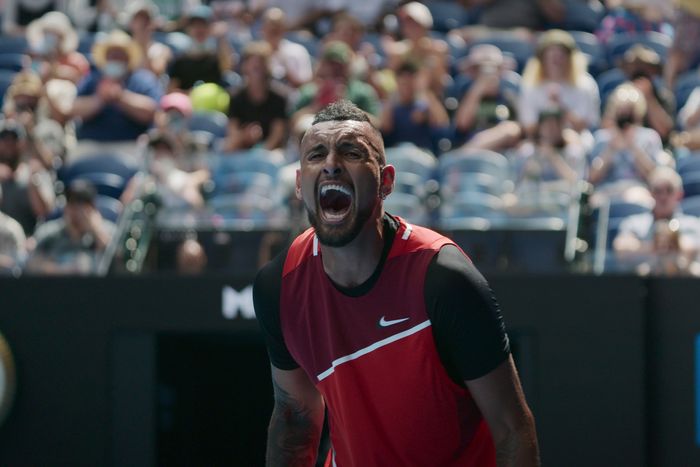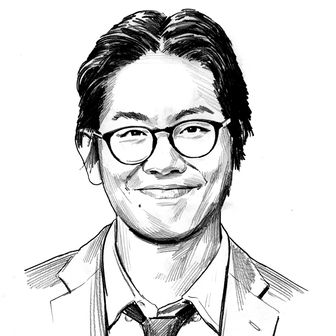
Glory is remarkably scarce in Break Point, the new Netflix docuseries about the rarified world of professional tennis from the Drive to Survive team. In a sense, it’s only fitting. Pro tennis is a sport where the majority of participants struggle to stay in the game financially; a talking head tells us a $100,000 first-round prize can make a player’s entire season. Vanishing few are able to sustain a long career, let alone taste victory at the four premiere tournaments collectively known as the Grand Slam. There’s a distinct bleakness to the sport as depicted in Break Point, one that serves as a refreshing contrast to the high-flying rich-boy drama of Drive to Survive.
Netflix dropped Break Point’s first five episodes, covering the opening half of the 2022 ATP season, late last week. (The remaining episodes will arrive in the summer, a choice that stalls momentum and does Break Point a real disservice.) Much like other sports docuseries, including Drive to Survive and All or Nothing, that essentially double as season recaps, Break Point’s central challenge is delivering material that’s compelling enough to withstand the easy reach of recent history: Tennis fans going into the show already know match outcomes, and unfamiliar viewers are just a few Google searches away.
The show’s answer lies in narrowly focusing on individual backstories — and, more pointedly, fully embracing the tragic but emotionally rich fact that most of its main characters ultimately end their journeys in failure. Each episode trains its attention on one or two promising competitors on the brink of taking their careers to the next level. As we follow them through a competition, we’re told, constantly and emphatically, about the details of their pedigrees, lives, potential. Expectations swell and swell and swell, only for us to watch the player slam face-first into a wall. The resulting effect can be repetitive, but then again, such is the nature of sport.
In the men’s game, that wall usually takes the form of a Spanish demigod: Rafael Nadal, the 22-time Grand Slam–winning great whose cartoonishly swollen forearms are the stuff of legend. (Though he’s been looking mortal lately, crashing out early in this year’s Australian Open.) Three of the five male players profiled in the first half of the series — Matteo Berrettini, Félix Auger-Aliassime, and Casper Ruud — all have journeys that end in defeat at the hands of Nadal. It’s rough, but what gives these stories a frisson of mythology is how the men are presented to us as the generation-in-waiting after Nadal, Novak Djokovic (another wall, when he’s not being deported for refusing COVID vaccination), and Roger Federer, who retired last year. Will their time ever come? Maybe, maybe not.
For the women, defeat looms more dynamically. Their game has been slightly wider open for some time now, even well before the official end of Serena Williams’s historic career. (The past four years have seen Grand Slam titles cycle through nine women; the same period saw only three men other than Nadal and Djokovic claim Grand Slam titles, at just one a piece.) This makes it anybody’s moment to seize the women’s game, which, of course, only makes the inability to do so for the players chronicled in Break Point — notably, Maria Sakkari, Ajla Tomljanovic, and Paula Badosa — ever more tragic.
Even the successes that are documented onscreen tend to feel a little painful. It makes sense that Break Point would build an entire episode around Nick Kyrgios, the electrifying Australian pro with a knack for self-combustion. Brilliant but utterly volatile, Kyrgios cuts as close to a perfect Drive to Survive–style docu-figure as you’re going to get. The debut episode quickly gets to his second-round defeat by the Russian Daniil Medvedev at the Australian Open before following Kyrgios as he pairs up with a childhood friend and ultimately plows through the doubles tournament to victory. Now, the doubles’ game tends to evade the kind of respect afforded the singles (unfairly); it gets less televised coverage, and the buzz around Grand Slam doubles winners tends to be muted at best. To its credit, Break Point treats Kyrgios’s doubles victory as a rousing triumph, but when held against the context of his broader solo career arc, it’s hard not to feel that win as little more than a consolation. Similarly, the fourth episode culminates with Ons Jabeur’s victory at another precursor tournament, the Madrid Open. Jabeur is one of the more fascinating stories in tennis: She’s the highest-ranking Arab and African player in the pro game, and coming from Tunisia, she’s doing it all with far less resources than peers from countries with more established tennis-development systems. Winning the Madrid Open was big for Jabeur, but once again, most watching can easily learn what happens to the rest of her season: two Grand Slam finals appearances, two heartbreaking losses.
One might wonder why Break Point doesn’t spend much time on the major winners. The answer is almost certainly banal: There’s little incentive, at this point anyway, for the biggest stars to subject themselves to the invasiveness of the docuseries experience. A similar lack was present in the initial seasons of Drive to Survive, which were notably devoid of perennial winner Lewis Hamilton. There’s also the fact that a whole other half to the season still awaits; we might still get a look at the young phenom Carlos Alcaraz yet.
Still, there’s something piercing and true about the bleak ignobility on display. “We all learn how to lose,” says Sakkari, quintessentially one of those players who’s always on the brink of deliverance. “Unless you are Roger, Rafa, or Novak, that’s a different story. The rest of us, we’re going to lose more than we win.” Sports stories have long tended to focus on variations of greats: great winners, great losers, great rivalries, great scandals, great tragedies. But what about the more common but no less majestic experience of just being in the struggle? Where Drive to Survive highlighted that humanity, perhaps counterintuitively, by illustrating how the Formula One world is just powered by messy divas, Break Point does the same by committing to the droning pain of the game. There’s almost a zenlike quality to its portraits of failure: tennis as a divine slog. Most who play will fail, but there’s beauty in that. Glory be to the losers.





